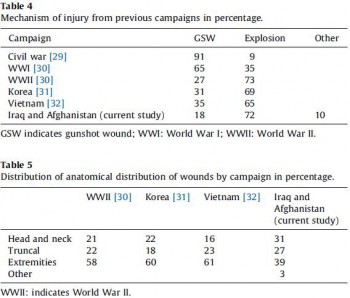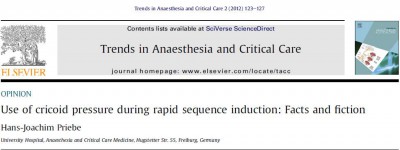18/06/2014
Oxygène chimique: Le système ROG
| Tags : oxygène
13/06/2014
Airway Cam Portal
| Tags : airway
12/06/2014
Traumatisé de guerre: Cela évolue
Systematic review of the prevalence and characteristics of battle casualties from NATO coalition forces in Iraq and Afghanistan
Hoencamp R. et All. Injury, Int. J. Care Injured 45 (2014) 1028–1034
Background: The North Atlantic Treaty Organization (NATO) coalition forces remain heavily committed on combat operations overseas. Understanding the prevalence and characteristics of battlefield injury of coalition partners is vital to combat casualty care performance improvement. The aim of this systematic review was to evaluate the prevalence and characteristics of battle casualties from NATO coalition partners in Iraq and Afghanistan. The primary outcome was mechanism of injury and the secondary outcome anatomical distribution of wounds.
Methods: This systematic review was performed based on all cohort studies concerning prevalence and characteristics of battlefield injury of coalition forces from Iraq and Afghanistan up to December 20th 2013. Studies were rated on the level of evidence provided according to criteria by the Centre for Evidence Based Medicine in Oxford. The methodological quality of observational comparative studies was assessed by the modified Newcastle-Ottawa Scale.
Results: Eight published articles, encompassing a total of n = 19,750 battle casualties, were systematically analyzed to achieve a summated outcome. There was heterogeneity among the included studies and there were major differences in inclusion and exclusion criteria regarding the target population among the included trials, introducing bias. The overall distribution in mechanism of injury was 18% gunshot wounds, 72% explosions and other 10%. The overall anatomical distribution of wounds was head and neck 31%, truncal 27%, extremity 39% and other 3%.
Conclusions: The mechanism of injury and anatomical distribution of wounds observed in the published
articles by NATO coalition partners regarding Iraq and Afghanistan differ from previous campaigns. There was a significant increase in the use of explosive mechanisms and a significant increase in the head and neck region compared with previous wars.
05/06/2014
Réflexions US sur l'accès aux voies aériennes
Advances in prehospital airway management
Jacobs PE et all. Int J Crit Illn Inj Sci. 2014 Jan-Mar; 4(1): 57–64.
Prehospital airway management is a key component of emergency responders and remains an important task of Emergency Medical Service (EMS) systems worldwide. The most advanced airway management techniques involving placement of oropharyngeal airways such as the Laryngeal Mask Airway or endotracheal tube. Endotracheal tube placement success is a common measure of out-of-hospital airway management quality. Regional variation in regard to training, education, and procedural exposure may be the major contributor to the findings in success and patient outcome. In studies demonstrating poor outcomes related to prehospital-attempted endotracheal intubation (ETI), both training and skill level of the provider are usually often low. Research supports a relationship between the number of intubation experiences and ETI success. National standards for certification of emergency medicine provider are in general too low to guarantee good success rate in emergency airway management by paramedics and physicians. Some paramedic training programs require more intense airway training above the national standard and some EMS systems in Europe staff their system with anesthesia providers instead. ETI remains the cornerstone of definitive prehospital airway management, However, ETI is not without risk and outcomes data remains controversial. Many systems may benefit from more input and guidance by the anesthesia department, which have higher volumes of airway management procedures and extensive training and experience not just with training of airway management but also with different airway management techniques and adjuncts.
| Tags : airway, intubation
01/06/2014
Pression cricoïdienne: Plus recommandé
La manoeuvre de Sellick, si classique, n'est plus recommandée ou du moins il est considéré qu'elle ne dispose plus d'assez d'arguments pour en faire une manoeuvre obligatoire.
Cliquez sur l'image qui suit pour un point actualisé
Les recommandations de l'Eastern Association for the Surgery of Trauma
| Tags : intubation




